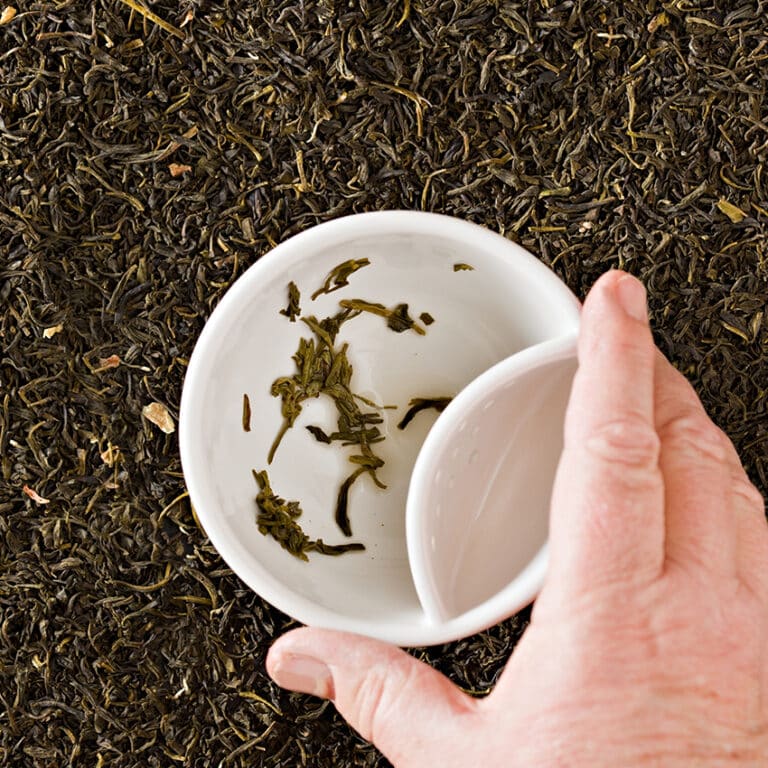If you’ve ever wanted to practice divination without the Tarot cards, crystal balls, or stars, you may want to take a closer look at tasseography — all you need is the tea already in your cabinet! (Tea lovers… this one is for you).
Despite its seemingly simplistic nature, tasseography, or tea leaf reading, can be just as serious, ritualistic, and powerful as you would like it to be — just as well as any other form of divination.
So, let’s get it brewing!
With your favorite teacup at hand and some new tasseography knowledge and tips, you’ll be divining away with your go-to tea blend in no time.
What is Tasseography?
Also known as tasseology or tasseomancy, tasseography is simply the art and divination practice of reading tea leaves.
The practice of tea leaf reading is a lot like what it sounds like — with some tea leaves and your favorite teacup, you read the tea leaves as you see them, whether inquiring about your past, present, or future.
This comes down to making out and interpreting shapes and symbols that have been formed after the querent drinks their tea. Like with scrying or dream work, this divination method relies on the reader to understand messages from symbols and abstract ideas.
Unlike the Tarot, for example, which has a set of 78 cards, there are infinite images, symbols, and shapes that you could ultimately receive from tasseography.
Thus, if you enjoy the abstraction and come into the practice with an open mind, you might prefer the art of tasseography more than other divination forms!
Discover even more forms of divination: 5 Underrated & Powerful Divination Systems
How to Read Tea Leaves
Getting Started With Tasseography
There are a variety of rituals and practices that you might prefer in your tea leaf reading practice. Chances are, you’ll develop your own style and preference as you practice!
Universally, however, to get started, you will need:
- A teacup
- Some loose leaf tea
If you would like to light incense or a candle, set some mood lighting, or perhaps even meditate before you brew up your tea, you can also do that to set a more sacred tone or space if preferred.
Below is a common method that we love that you can use if you have yet to develop your own tea leaf reading style. However, feel free to change, alter, or add things to the method as you please!
- Brew up your favorite loose leaf tea and select a teacup and saucer of your choice (an actual teacup over a mug is ideal as it has the right space and dimensions for the tea leaves to move and breathe). Now for the fun part — assuming you’re the one getting the reading, drink your tea!
- As you brew the tea, contemplate your question that you would like answered. If you would prefer general guidance, you can focus on a question like: “What do I need to hear right now?”
- Stop with just a little (around a half teaspoon to teaspoon) tea left in your cup.
- Swirl the cup, with the remaining tea and leaves, three times with your non-dominant hand.
- Now, with some care and caution, flip your cup over your saucer so that the leftover liquid can drain and leave only the leaves.
- When you’re ready to flip the cup back up, make sure that the handle is facing you.
Now you’re ready to interpret your tea leaves!
Common Tea Leaf Reading Shapes & Meanings
The heart of the practice of tea leaf reading is here: interpreting the shapes, symbols, and images that you see in your cup.
Here are some common tea leaf shapes and images that often come up if you find yourself getting stuck:
- Numbers — Perhaps you asked a question about timing! In this case, numbers can be a clear answer. Alternatively, you can take the numerological significance of the number(s) you’re seeing.
- Animals — Animals all have their own significance and meaning; hence why zodiac signs also often have animal correspondences. An animal meaning dictionary can help you decode what an animal shape is trying to communicate to you!
- Flowers — If you can make out even the different kinds of flowers that you’re seeing, you can make a connection between the typical flower meaning and the message at hand (for example, a rose might be indicative of romance or a loved one in mind).
- Shapes — Hearts, squares, circles, and all other miscellaneous shapes can be a message, too, no matter how simple this initially seems. For example, a heart could signal love, or a circle could mean the end or beginning of a cycle!
Ultimately, what you see and how you interpret these images is up to you. More than anyone, you personally will know and intuitively understand your leaves the best — after all, they are meant for you!
Will You Try Tasseography?
Depending on how you view it, tea leaf reading can be either seemingly extremely simple or very complex and daunting.
While the tools you need are perhaps not as extensive or fancy as other divination methods, tasseography has the potential to be an extremely expansive and far-reaching practice with its messages and symbols.
That said, you should try as much as possible to release any nerves or concern over your ability to read the tea leaves — like with anything, it just requires time and practice!
The power to divine accurately and powerfully is always inside you… or at the very least, within your household teacup!
Related article: Your Ultimate Guide to Using Rune Stones
